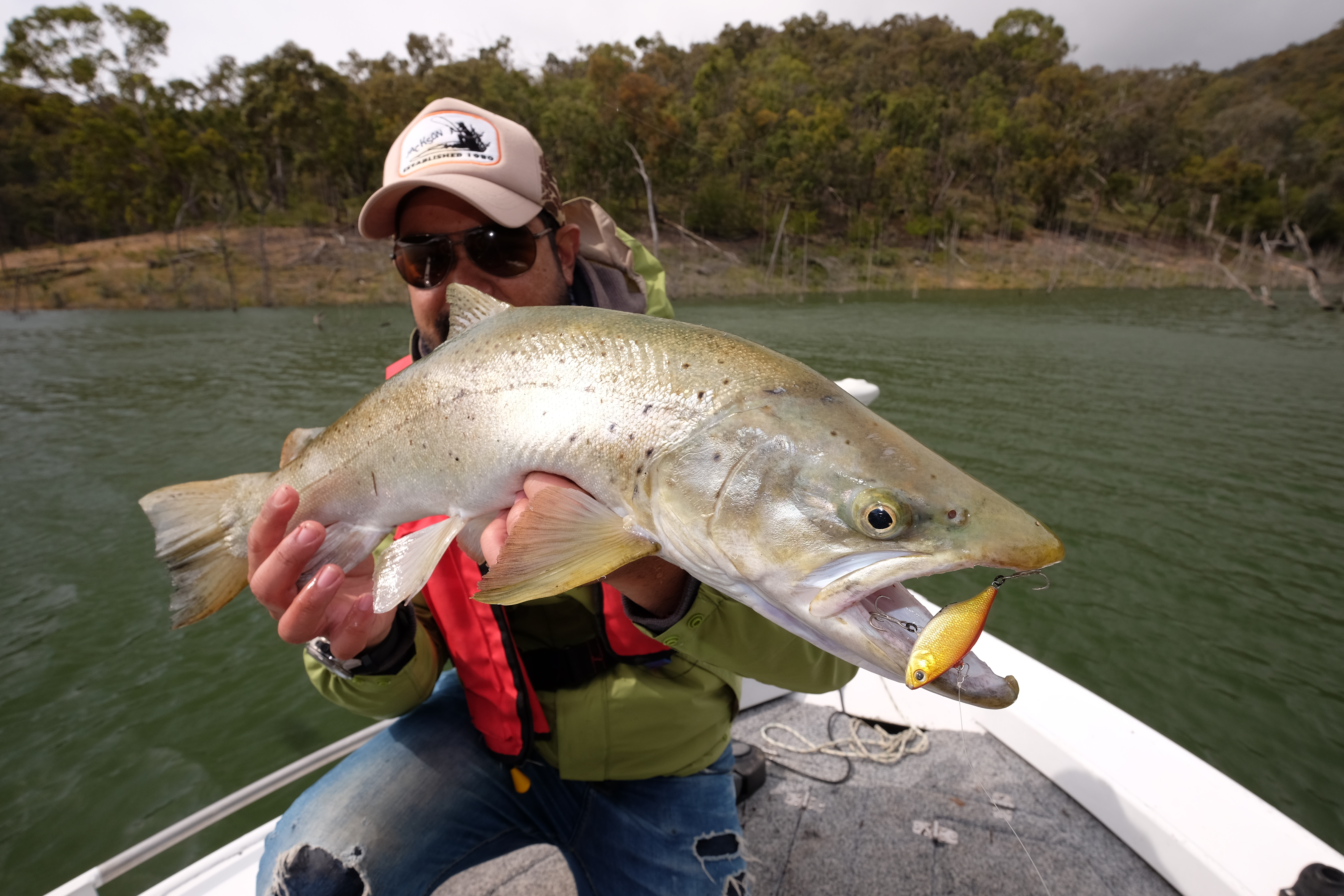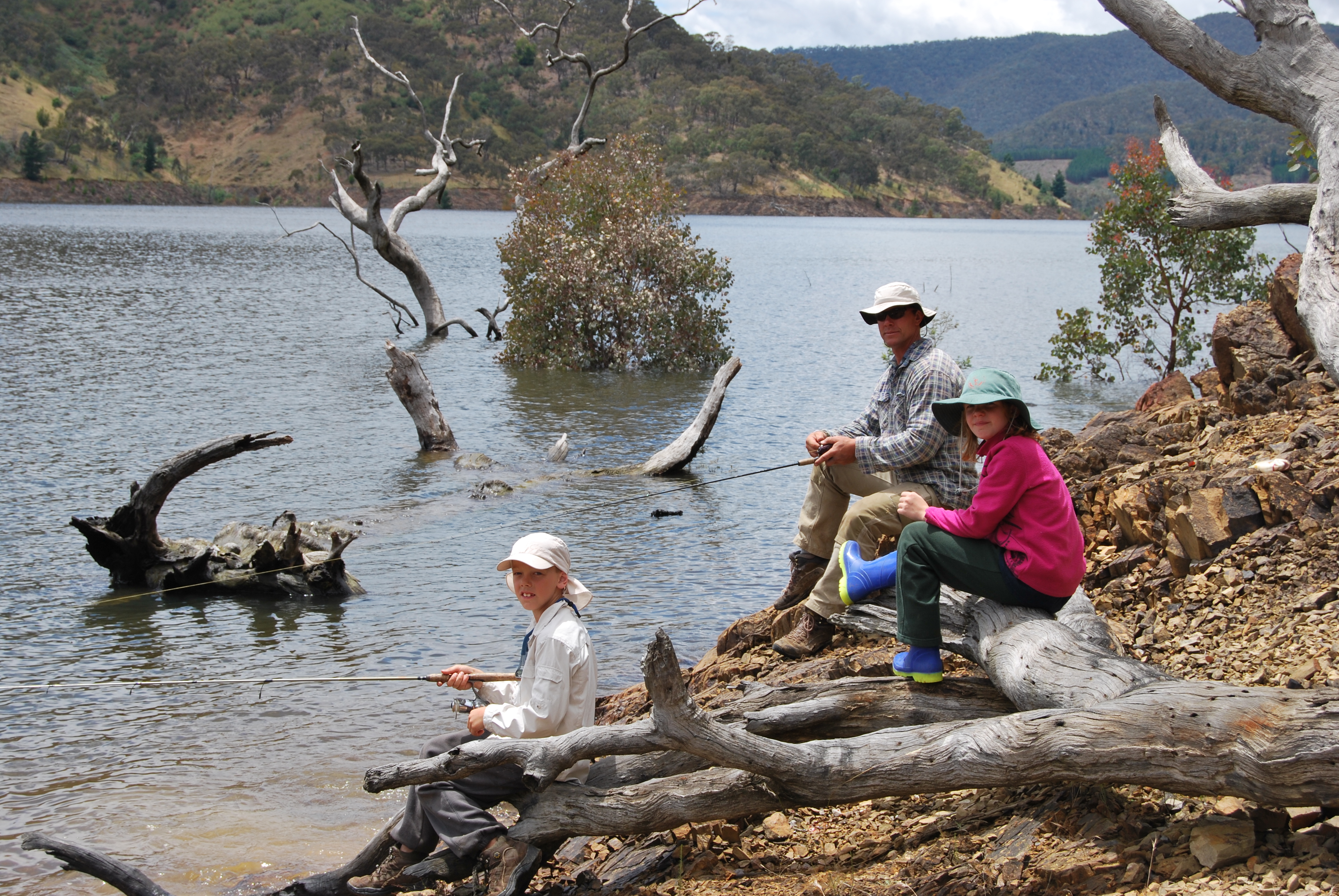How to catch trout
Trout in Eildon can be caught in several ways to suit your preferred style, level of enthusiasm and experience. Boat fishers commonly troll with a variety of lures near the surface (flatlining) and deeper down through the water column. Shore-based fishers can walk the bank with a spin rod casting lures or a fly rod to ‘cover ground’ and find active fish. Family friendly bait fishing in one spot is probably the easiest and least fuss approach that can still yield fantastic results.
 Trolling
Trolling
The attraction of trolling large bodies of water such as Eildon is that fishers can actively find where fish are holding on a given day. It’s a relatively simple way to fish for trout unless you want to make it technical with specialised equipment. Trout can be caught in open water too. It’s not uncommon to find them in the middle of the main arm near the surface where they will be scouting about for small bait fish.
Trollers usually go as slow as their boat allows and will have a couple of lines out well behind the boat covering a mixture of depths. Some tried and tested lures are winged models like Tasmanian Devils and smaller floating minnows like Rapalas. Even bait can be trolled such as a scrub worm or mudeye, usually behind an attractor device such as a cow bell or ford fender. Trollers also use specialised methods to run lures at considerable depth: downriggers, paravanes or lead core lines are all options and vary in price substantially. The good news is that paravanes are less than $15 and can present lures at 35-40ft on standard spinning gear. A 6-to-7-foot medium actioned rod with a 2500 sized reel, 3kg braided line and 4kg leader of about 6 foot are perfect.
Shore-based
Active fishers love to walk or wade their way around the shoreline with a fly or spin rod and employ a method of cast and move. By firing fanned out casts, then moving to the left or right and repeating the process it’s possible to cover a good stretch of shoreline and intersect active trout. This prospecting style of fishing will be served well by the same lures used to troll with, favouring ones that can be flung a long way.
Fly fishers will fair well using wet flies but won’t be able to cover near as much water as the spin gear casters. Longer rods will help cast further to cover more water, so a 7-to-7.5 foot medium actioned rod with a 2500 sized reel, 3kg braided line and 3 or 4 kilo leader of about 6 foot does the job well. For the fly casters, a forward weighted line for longer casts is essential. Both styles should focus on low light periods and target lake edges.
 Bait fishers do well fishing a variety of natural and artificial baits. Mudeyes, glassies, earth worms, Powerbait or other dough like baits work well. If you can figure out what the trout are feeding on and replicate it, you’ll be on a winner. It pays to match hook sizes carefully with bait sizes as any trout will inspect bait thoroughly before eating it. If it doesn’t look amazing to you, a trout is likely to think the same! With bait fishing it pays to use rigs that minimise anchoring the bait to the bottom too firmly. Use the lightest sinkers possible or a float to keep baits from getting lost in the weed. The same tackle for shore casting is best. Just add a good rod holder so you can anchor things down and your rod doesn’t end up skating into the water. In the early morning and evening trout cruise the edges, especially if the lake’s water level is rising, so it’s best not to cast out too far at those times.
Bait fishers do well fishing a variety of natural and artificial baits. Mudeyes, glassies, earth worms, Powerbait or other dough like baits work well. If you can figure out what the trout are feeding on and replicate it, you’ll be on a winner. It pays to match hook sizes carefully with bait sizes as any trout will inspect bait thoroughly before eating it. If it doesn’t look amazing to you, a trout is likely to think the same! With bait fishing it pays to use rigs that minimise anchoring the bait to the bottom too firmly. Use the lightest sinkers possible or a float to keep baits from getting lost in the weed. The same tackle for shore casting is best. Just add a good rod holder so you can anchor things down and your rod doesn’t end up skating into the water. In the early morning and evening trout cruise the edges, especially if the lake’s water level is rising, so it’s best not to cast out too far at those times.
Click here for catch limits on brown trout
